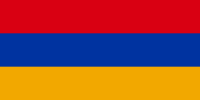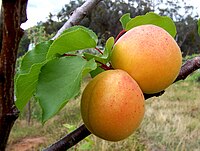National symbols of Armenia
Appearance
The national symbols of Armenia have a long history and encompass thousand-year-old traditions of the Armenian people, as well as Armenian heraldic, musical and artistic traditions. This page provides an incomplete list of those symbols.
Official symbols
[edit]| Image | Name | Description | Date |
|---|---|---|---|
| The flag of Armenia is consisted out of three colour stripes of the same width: red, blue, orange, from top to bottom, the width-length ratio of the flag is 1:2. Red symbolises the Armenian highlands, the Armenian people continuous struggle for survival, maintenance of the Christian faith, Armenian freedom and independence. Blue symbolises the will of Armenian people to live under the peaceful skies, and the orange symbolises the hard-working nature and the creative talent of the people of Armenia.[1] | Adopted on 15 June 2006 | ||
| The coat of arms of Armenia is a rendition of the coat of arms of the First Republic of Armenia, which existed between 1918 and 1920. On the shield in the center, the mount Ararat is depicted with the Noah's Ark on top, which is one of the symbols of modern Armenia. The four Armenian royal dynasties are depicted in clockwise direction from top-left: Bagratids, Arsacids, Rubenids and Artaxiads. There is a lion to the right of the shield and an eagle to the left. In the bottom there is a sword, a branch of a tree, a bundle of spikes, a chain and a ribbon. Armenian coat of arms has the colors of Armenian flags. | Adopted on 19 April 1992 | ||
| The anthem of the Republic of Armenia is called "Mer Hayrenik"/"Our Fatherland". It is the slightly modified version of the Anthem of the First Republic of Armenia, and based on the poem by Michael Nalbandian with the music composed by Barsegh Kanachian. | Adopted on 1 July 1991 |
Unofficial symbols
[edit]| Image | Name | Category | Description |
|---|---|---|---|
| Hayk Nahapet | National founder | Considered the traditional founder of Armenia, to which he gave his namesake (Hayk/Hayastan) and occasionally considered as the ancestor to all Armenians. | |
| Gregory the Illuminator | Patron saint | Founder and first official head of the Armenian Apostolic Church. | |
| Mount Ararat | National mountain | Ararat is a sacred mountain for Armenians. Armenians believe that Noah's Ark landed on it and became the foundation of the Armenian nation. It is one of the most recognizable and iconic national symbols of Armenia.[2] | |
| Duduk | National musical instrument | The duduk is an Armenian national instrument. The original name for this instrument is tsiranapokh, which roughly translates as an "apricot tube". Duduk's are made solely out of apricot wood, since it gives it a distinct sound.[2] | |
| Apricot | National fruit | The academic name for apricot is "Prunus Armeniaca" due to the suspected Armenian origin, as Alexander the Great originally brought the fruit from Rome. The fruit plays an enormous role in Armenian culture and folklore. The Armenian national musical instrument, duduk, is made from apricot tree wood.[2] | |
| Khachkars | Armenian cross stone | Cross-stones or khachkars is an ancient Armenian symbol unique to Armenian culture of the great architectural value. Khachkars are made on variety of occasions: victory in a war, death of a person, completion of construction of a temple or a bridge and et. cetera. Every khachkar differs from one another, so it is almost impossible to find an identical one. | |
| Forget-me-not | National flower | Forget-me-not is a symbol of the commemoration of the Armenian genocide and appeared following its Centennial. The yellow part symbolizes the memorial of Tsitsernakaberd, and the purple colour denotes the recognition and the condemnation of the genocide.[3] | |
| Lion | National animal | The lion is an Armenian national animal and was the symbol of various Armenian dynasties from the Bagratids to Rubenids. Currently, however, lions are not present on the territory of Armenia. | |
| Arevakhach | Armenian cross | Roughly translating as "sun-cross", Arevakhach is an ancient Armenian symbol with its origins hailing from the Kura–Araxes culture.[3] | |
| Eagle of Taron | National animal | Symbol of Tseghakronism. An eagle with a sword in one claw and a cut snake in another one. | |
| Dragon of Hayk | National animal | Symbol of Hayk Nahapet and Haykaznuni dynasty. Often depicted as a seven-headed dragon. | |
| Armenian dram | National currency | The historical currency of Armenia. | |
| Armenian Taraz | National dress | Histotical dress of Armenia |
See also
[edit]- Armorial of Armenia
- Art of Armenia
- Culture of Armenia
- Flags of Armenia
- History of Armenia
- Music of Armenia
- Symbols of Europe
References
[edit]- ^ "State Symbols". 20 October 2024.
- ^ a b c "National Symbols of Armenia". Armenia Travel. 25 September 2023.
- ^ a b Global, AIST. "The symbols of Armenia". armeniadiscovery.com. Retrieved 2024-10-20.

















